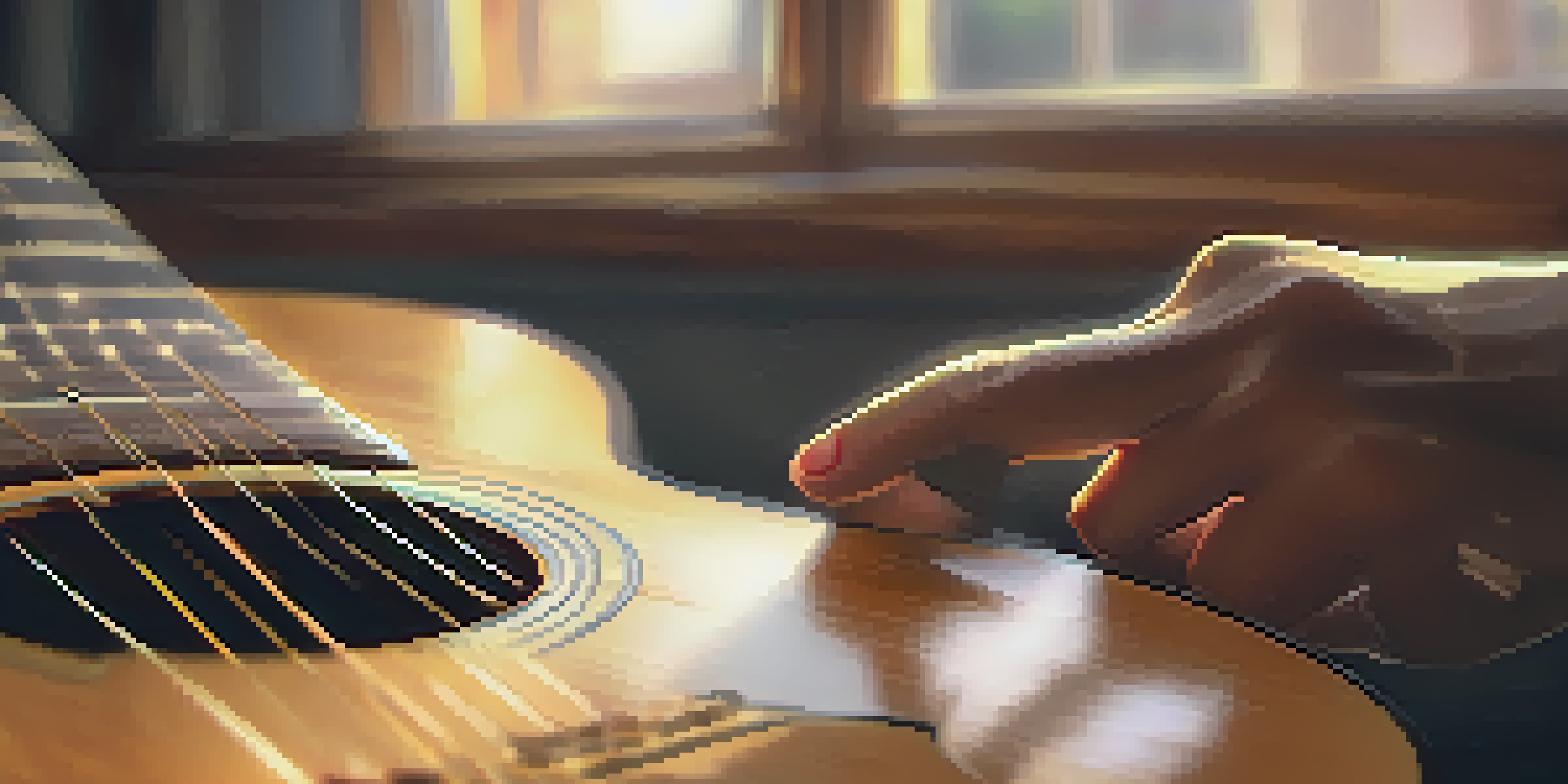Beginner's Guide to Fingerstyle Guitar: Tips and Tricks

Understanding Fingerstyle Guitar Basics for New Players
Fingerstyle guitar is a technique where you use your fingers instead of a pick to play the strings. This approach allows for a more nuanced and dynamic sound, making it popular in various genres such as folk, classical, and blues. As a beginner, grasping the basics is crucial for developing your skills and confidence.
The beautiful thing about learning is that no one can take it away from you.
Start by familiarizing yourself with the parts of the guitar, as well as the proper posture and hand position. A relaxed grip will help you play more fluidly, while ensuring you're seated comfortably can make a significant difference. The goal is to create a harmonious relationship between your body and the instrument.
Once you’re comfortable, practice plucking the strings with your thumb and fingers. This foundational exercise will help you develop coordination and finger independence, essential for more complex fingerstyle techniques down the road.
The Importance of Finger Placement and Technique
Proper finger placement is vital in fingerstyle guitar. Position your thumb over the bass strings and use your index, middle, and ring fingers for the higher strings. This allows you to create a clear and balanced sound without the strings getting muddled together.

As you play, focus on keeping your fingers relaxed and your movements fluid. Tension can lead to mistakes and discomfort, so try to stay loose. Utilizing a metronome can also help you develop a steady rhythm as you work on finger placement techniques.
Master the Basics of Fingerstyle
Understanding finger placement and posture is essential for developing skills and confidence in fingerstyle guitar.
Remember to practice slowly at first, gradually increasing your speed as you become more comfortable. This way, you’ll build muscle memory without sacrificing the clarity of your notes.
Essential Fingerstyle Patterns to Start With
Once you’ve grasped the basics, it’s time to dive into some fingerstyle patterns. Start with simple arpeggios, which involve picking the strings in a sequence. For example, pluck the bass string with your thumb, followed by the higher strings with your fingers in a flowing motion.
Practice does not make perfect. Only perfect practice makes perfect.
Another useful pattern is the Travis picking technique, which alternates between the bass and treble strings. This rhythmic style provides a solid foundation for many songs and helps you develop a sense of timing.
Practicing these patterns regularly will not only enhance your fingerstyle technique but also improve your overall guitar playing. Try incorporating them into your practice sessions to see noticeable progress.
Building Finger Strength and Endurance for Better Playing
Finger strength and endurance are crucial for executing more complex fingerstyle pieces. Start with simple exercises that focus on individual finger movements, such as pressing down on frets while plucking strings. This will build the necessary strength in your fingers.
You can also try squeezing a stress ball or using finger exercisers to improve your grip strength. Incorporating these exercises into your daily routine, even if just for a few minutes, can greatly enhance your playing ability.
Practice Essential Patterns Regularly
Incorporating simple patterns like arpeggios and Travis picking into your practice can significantly enhance your fingerstyle technique.
As you build strength, remember to take breaks and avoid overexerting your fingers. This will help prevent injuries and keep your practice sessions enjoyable.
Choosing the Right Guitar for Fingerstyle Playing
Selecting the right guitar can significantly impact your fingerstyle experience. Generally, acoustic guitars are preferred for fingerstyle playing due to their rich sound and resonance. However, classical guitars, with their nylon strings, can also provide a soft and warm tone.
Consider the size and shape of the guitar as well. Smaller-bodied guitars can be more comfortable for beginners, while larger models may offer a fuller sound. It’s essential to choose an instrument that feels good in your hands and suits your playing style.
Ultimately, the best guitar for you is one that inspires you to play. Visit a local music store and try out different models to find the perfect fit for your fingerstyle journey.
Learning Songs and Building Your Repertoire
As you grow more comfortable with fingerstyle techniques, it’s time to start learning songs. Choose simple pieces to begin with, like folk or pop songs that feature fingerstyle patterns you’ve practiced. This will keep you engaged and motivated as you progress.
Online resources, including video tutorials and tablature, can be incredibly helpful when learning new songs. Websites and apps dedicated to guitar education often provide a wide variety of fingerstyle arrangements for different skill levels.
Choose the Right Guitar for You
Selecting a comfortable guitar that suits your style can greatly improve your fingerstyle experience and motivation to play.
Remember to take your time with each song, breaking it down into manageable sections. This approach will help you master the piece without feeling overwhelmed and allow you to enjoy the learning process.
Practicing Regularly: The Key to Mastery
Consistent practice is essential for mastering fingerstyle guitar. Aim for short, focused practice sessions rather than long, overwhelming ones. Even 15 to 30 minutes a day can lead to significant improvements over time.
During your practice, set specific goals for each session, whether it’s working on a new technique, mastering a song, or improving finger strength. This will give you a clear direction and keep your practice engaging.

Lastly, don’t forget to celebrate your progress! Recognizing your achievements, no matter how small, will motivate you to keep going on your fingerstyle journey.